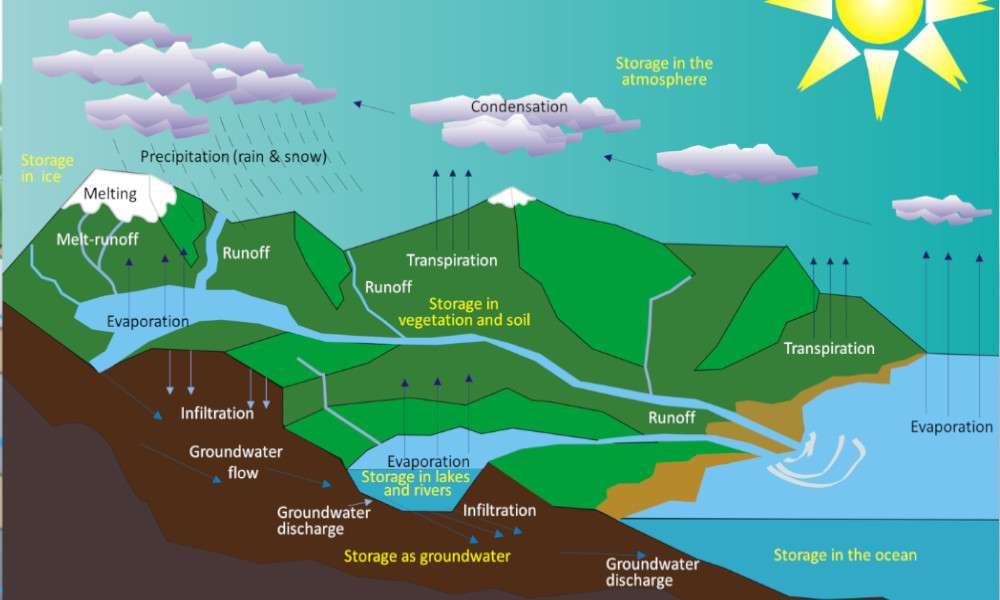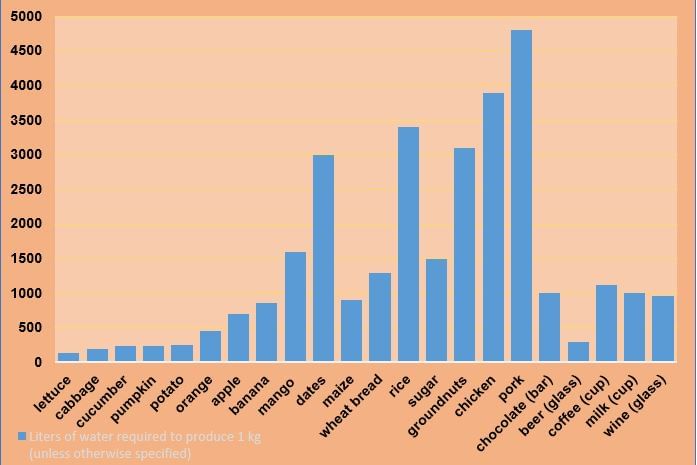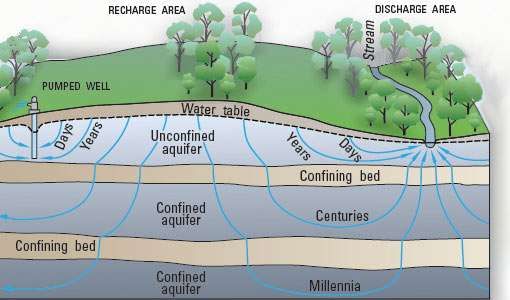Getting to Know Your Water Footprint
Did you know that planting trees can help reduce your water footprint? Read on to see the invisible ways you’re using water and what you can do about it.

You might be using more water than you think. Most people try to conserve water by closing the faucet when they brush their teeth or shower instead of taking a bath. They might wash their cars less frequently or install low flow taps.
While all these measures help the environment, what people don’t realize is that they are using a huge amount of “invisible” water. For example, eating a couple of chocolate bars will wipe out all your water conservation efforts during the week, because one kilo of chocolate requires 15,000 liters of water to produce!
What is a Water Footprint?

Humans use water in innumerable ways from household uses to agricultural and industrial uses. Every good or service we consume takes a certain amount of water to produce. The water footprint measures precisely this consumption.Water footprints can be defined for various goods and services like cars, rice, etc. Or, for various entities like communities, corporations, countries, river basins etc. Water footprint can also be defined for every individual. For all the goods and services an individual consumes, he or she leaves behind a water footprint. Knowing your own water footprint can help you take better decisions to live more responsibly, especially at a time when India is going through a water crisis.
Visible Water vs Virtual Water
Some of the water that we consume every day is obvious, visible water: the water we need to drink or bathe or wash our dishes, clothes, and cars. However, everything we eat or use, from a cup of coffee to a plate of food to the clothes we wear to the cellphone in our pocket, takes water to produce. This is called virtual water. We may not be “consuming” this water directly, but nevertheless, water has been consumed at some point to produce these items.
Footprints of Fruits, Grains, and Meats
All of the food we eat has a water footprint. Leafy greens and other vegetables tend to have the lowest water footprint. Lettuce (130 L/kg), cabbage (200 L/kg), cucumber (240 L/kg), pumpkin (240 L/kg), and potato (250 L/kg) all require much less water to produce compared to other foods.
Fruits such as oranges (460 L/kg), apples (700 L/kg) and bananas (860 L/kg) are a slightly higher in terms of water footprint. With cereals, the water footprint increases a bit more: maize (900 L/kg), wheat bread (1300 L/kg), rice (3400 L/kg), sugar (1500 L/kg), and groundnuts (3100 L/kg).

Chart Courtesy : The Water Footprint of Food
Meat has the worst water footprint of all foods. This is because meats are a secondary diet, in the sense that chickens, pigs, and cows need to consume food, which itself takes a lot of water to grow, such as corn. This leads to a greater impact on water resources. It is not for nothing that scientists are recommending lowering global beef consumption as a prescription to reduce the planet’s carbon and water footprint. Chicken (3900 L/kg), pork (4800 L/kg), and beef (15,500 L/kg) all require tremendous amounts of water to produce. With meat products, a family sitting down for dinner can easily consume one kilo or more per day.
Some common indulgences such as chocolate, beer, coffee, and wine also generate a water footprint. Consumers must be aware that among most of their food choices, fruits and vegetables are the wisest food options not just for health, but also in terms of water conservation.
Subscribe

A Tale of Two Citizens
Let us follow a day in the life of Adarsh and Manish, two people with different water footprints, and see how their behaviors impact their visible and virtual use of water.
Adarsh lives the upper-class life, in the suburbs of a big city, with a huge house that comes with bathtubs, a pool, and three cars. He takes a bath in a tub two times a day (300 L), keeps the faucets running while brushing (150 L). He has a swimming pool that needs 300 L per day and uses 300 L to wash his three cars. He needs 60 L to wash his dishes and 100 L for watering his lawn. This makes his approximate visible water footprint a 1000 L a day.
On the other hand, Manish lives in an apartment, and he is very conscious about using less water. He bathes from a bucket (40 L), runs the faucet minimally (20 L), does not own a car or a pool. He washes the dishes by hand (40 L). Then, he uses some water for washing his clothes once a week. This makes his visible water footprint approximately 150 L a day.
When we look at Adarsh and Manish’s virtual water footprint, a different story emerges. Even though Adarsh lives a lavish lifestyle, he chooses to be vegetarian for health reasons. This puts his food footprint at a mere 600 L per day. With his higher income, he shops for clothes, watches, phones, etc. and that is another 2500 L a day. His electricity-based water footprint for the big house is 300 L. This totals to 3400 L a day. Thus his virtual footprint is more than twice his visible footprint.
Manish however indulges in all kinds of food and enjoys eating different meat dishes for lunch and dinner. Twice-a-day meat consumption means Manish is leaving a food footprint of 3000 L a day. His electricity comes to 100 L and shopping to 1500 L. This leaves a grand total of 4600 L for Manish’s virtual footprint.
So Manish has a total footprint of 4750 L a day, whereas Adarsh, despite his grand lifestyle, has a 4400 L of water footprint. This is despite the fact that Manish visibly consumes 1/6 of the water compared to Adarsh.
Millets as a Rice Alternative

Besides individual choices, the nation as a whole also has to make some choices to reduce water usage. As India’s rivers deplete, the present method of cultivation of rice has become a burden on the country’s water system. Rice has one of the largest water footprints among cereals. The popularity of rice has soared in the last century. India is a major exporter of rice, a crop which feeds humanity all over the globe. Once considered a meal of the rich, rice is now common place. Rice cultivation is well-suited to countries and regions with low labor costs and high rainfall, as it is labor-intensive to cultivate and requires ample water. In India, rice is one of the most commonly cultivated cereals and this puts a tremendous stress on water resources.
Millets, however, are the traditional staple of South India, and are much less labor intensive and require much less water. India is the highest consumer of these grains in the world. Millets are a healthy alternative substitute for common grains such as wheat and rice. The water footprint for most of the major millets is less than a quarter of rice’s water footprint.
All the eight major millets have lower carbohydrates than rice, more protein, more calcium, and more iron than rice. They also contain higher amounts of fiber and essential minerals. Little millet has 13 times more iron than rice. Foxtail and Proso millets have double the protein. Ragi millet has over 30 times the calcium as rice and requires 600 L of water per kg. If the nation moves towards millets as a staple diet, it will do a lot to address the water shortage in the country.
Unless Indians consider making a dramatic shift in the types of food they eat, the heavy burden on irrigation water and groundwater supplies will not be sustainable. A day will come when India runs out of water and dietary changes will become a mandate instead of a choice.
Trees for Water Storage

Ensuring we have enough tree cover over the land is another important aspect of ensuring our water bodies do not deplete. The water that is used to water crops and that flows through rivers can be replenished over time if enough trees are planted throughout the nation.
Water nourishes trees, and trees ensure the soil around them holds water. When rain falls, the root system ensures water on the surface percolates into the soil. This water slowly seeps in, to raise the water table over the years by filling the underground aquifers. The water table feeds lakes and streams, which in turn feed the rivers. This has a direct and profound impact on the availability of blue water.
Trees also slow down the rainwater runoff and retard seasonal flooding. They buffer the same water to release it over the course of the year to prevent dry season water scarcity.
How Many Trees to Plant?

The larger the reserve of blue water a country has, the larger the water footprint it can afford. For example, India has 1000 cubic meters of water per person, while Canada has 80,000 cubic meters! On average, a tree can retain 3900 L of water in the soil around it every year. The global average water use per person is 1.39 million liters per year or 3800 liters per day. Only 3.3% of this is in domestic water consumption for drinking, bathing etc. 4.3% is for industrial products such as phones etc. but not for clothes or food. 90% of this is virtual water for products we buy and consume.
So, if you would like to ensure your water footprint is sustainable, you would need 355 trees to be planted, to store up rainwater in the monsoon and replenish water bodies through the aquifers.
Cauvery Calling Campaign
One way to help manage your water footprint would be by contributing to Cauvery Calling. This first-of-its-kind campaign aims to change the face of the Cauvery basin by enabling the plantation of 242 crore trees by farmers on their fields. This action will increase water retention equivalent to 40% of the annual flow of Cauvery, and dramatically increase farmer’s income five-fold in 5 years. You can support Cauvery Calling by contributing ₹42 per tree.
Since 2017, the enormous success of Rally for Rivers has awakened a collective voice asking for a solution to India’s water crisis. Cauvery Calling can be a model for river revitalization helping to restore the ecological balance of the river, soil and climate, all across India and the tropical and sub-tropical world at large.



